Choosing the Right Gravel: Driveways, Paths, Drainage & More
Are you working on a project that requires gravel?
If so, you may be uncertain about what kind of gravel you should get. There are so many options—shapes, sizes, colors—should you just go with the cheapest option? Or is there more to it than that?
Whether you’re working on a driveway, a garden path, or a construction foundation, Zimmerman Mulch has got you covered! We offer gravel solutions for every kind of project.
In this post, we’ll walk you through the different types of gravel, what they’re used for, and how to choose the best one for your needs.
What is Gravel and How Does it Differ from Stone?
Gravel doesn’t seem that complicated. You see it all the time—in driveways, on paths, and in ditches. But when you suddenly need it for a project, you’re faced with a dozen different options: gravel, crushed stone, river rock, pea gravel, and more. What’s the difference?
All of these terms refer to loose aggregates of rock fragments. Some of these fragments occur naturally, like those found in riverbeds. Others are created by mechanically crushing larger stones into smaller pieces.
In the American construction industry, “gravel” often refers to naturally occurring rock, while “crushed stone” refers to material that’s been mechanically broken down. But in the landscaping world, the terminology blurs a bit.
At your local landscape supply store, crushed stone might be labeled simply as “gravel,” because in landscaping, “gravel” is a general term for any utilitarian rock material. More decorative stones—especially smooth, colorful, naturally rounded ones—might be labeled “river rock” or “stone.”
Confusing? A bit. But here’s a simple tip:
Crushed stone has sharp, angular edges and compacts well.
Natural gravel (like river rock or pea gravel) has smooth, rounded edges and tends to shift underfoot.
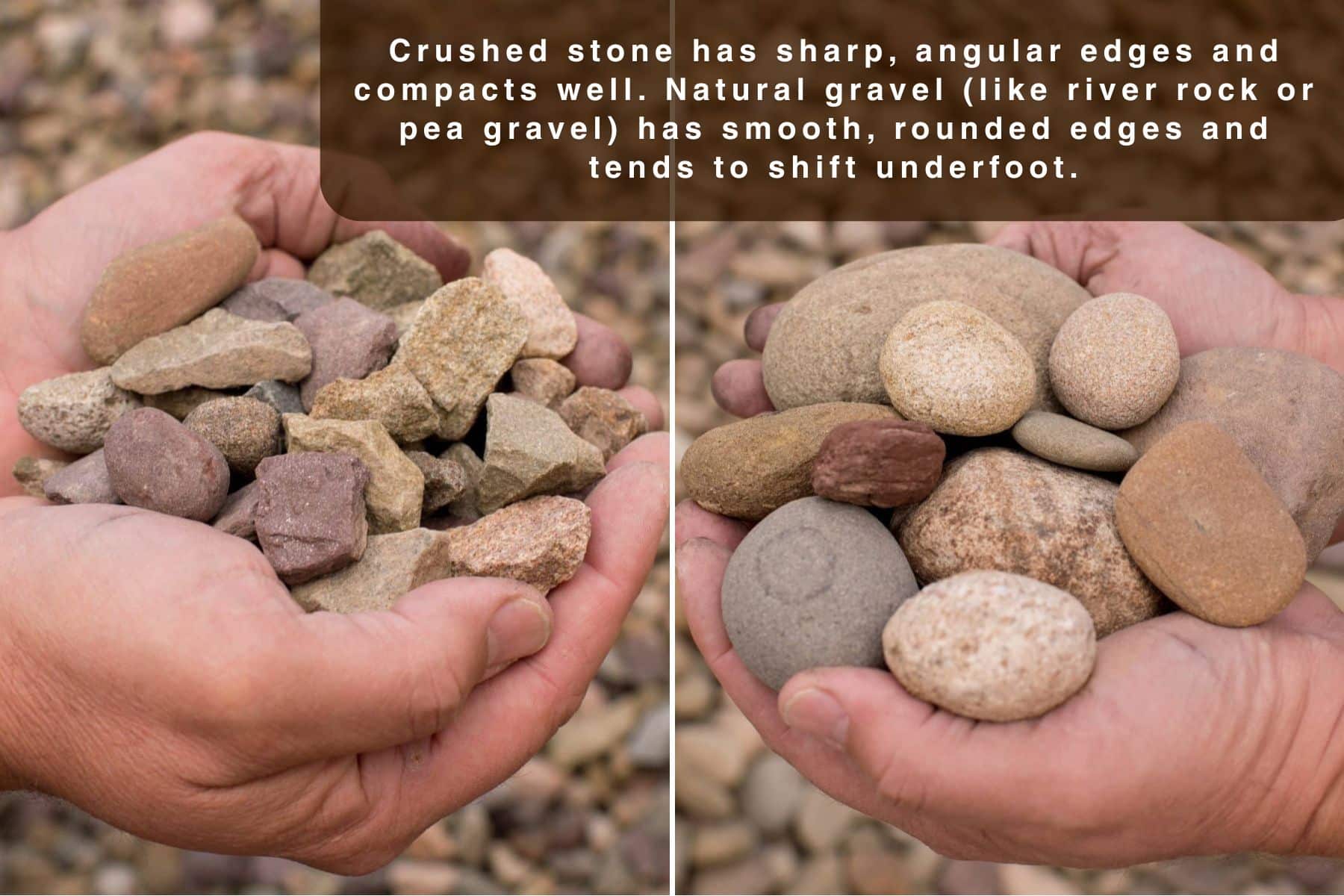
For more information about natural gravel and crushed stone, read our blog post on The Ultimate Crushed Stone and Gravel Buying Guide.
Different Gravel Types
Gravel varies in three main ways:
- How it’s made (crushed vs. natural)
- The color and material
- The size of the stones
We’ve already discussed crushed vs. natural gravel, but let’s take a closer look at how gravel material and size affect your project.
Color and Material
Gravel is made from many different types of rock, including:
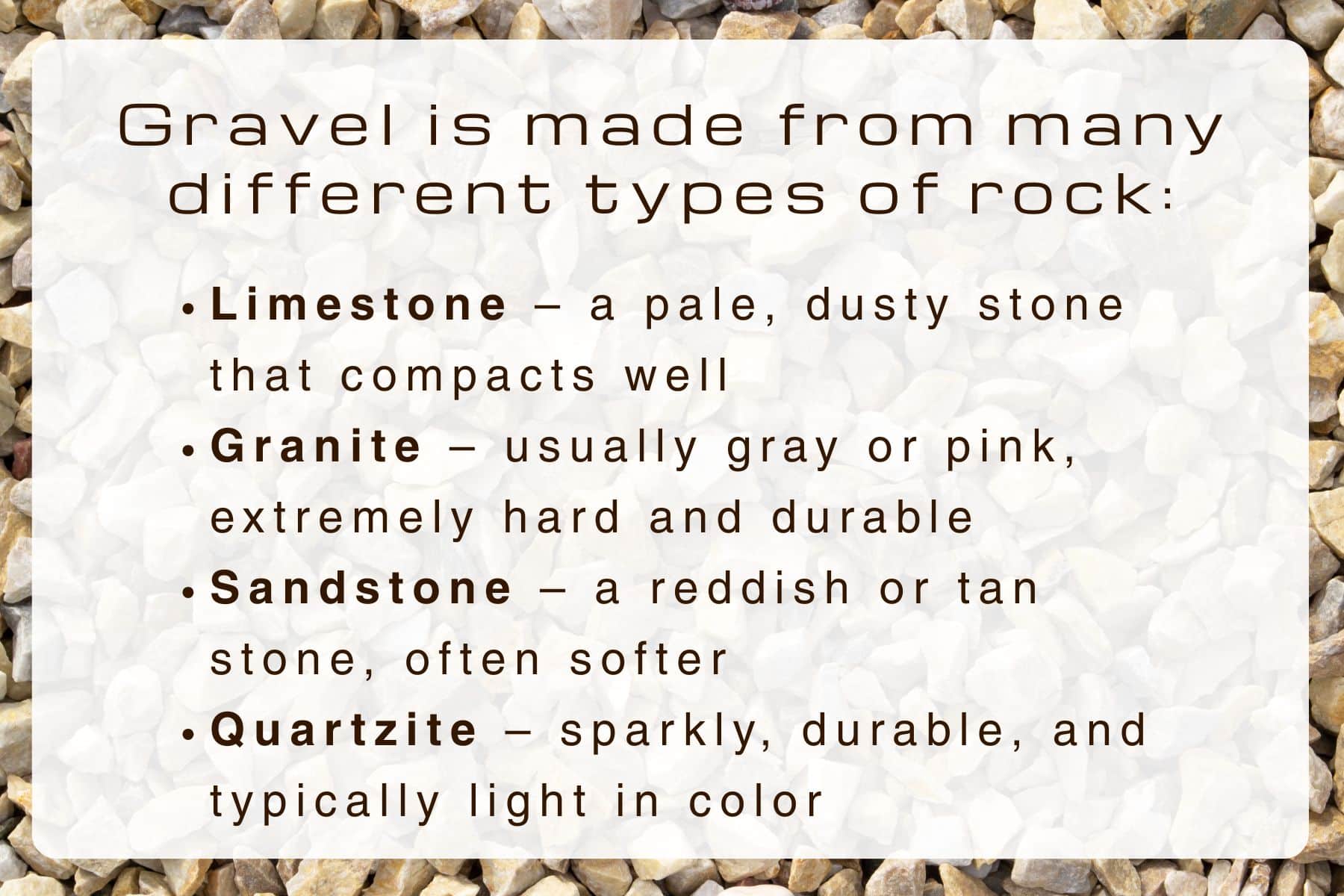
- Limestone – a pale, dusty stone that compacts well
- Granite – usually gray or pink, extremely hard and durable
- Sandstone – a reddish or tan stone, often softer
- Quartzite – sparkly, durable, and typically light in color
While the rock type can affect durability in some projects, functionally, one type of gravel usually works just as well as another. But if you’re working on a landscaping project, you’re probably much more concerned about the color.
For example, if you’re using gravel for stone pathways in the garden, the color will make a big difference in the overall look and vibe of your paths.
- Golden-white “pearl pebbles create a warm, bright look.
- Red-hued crushed stone adds a rich contrast to the green of the plants.
- Multicolored river rock gives a natural, organic feel.
Keep in mind that dark stones absorb heat and can become uncomfortable to walk on barefoot—especially in full sun.
Size
Gravel sizes are often sorted into categories by the size of the particles, usually measured in inches or millimeters. Confusingly, different suppliers sometimes use different terms for sizes, so always check the rock size that’s listed.
Here are some common gravel sizes and what they’re used for.
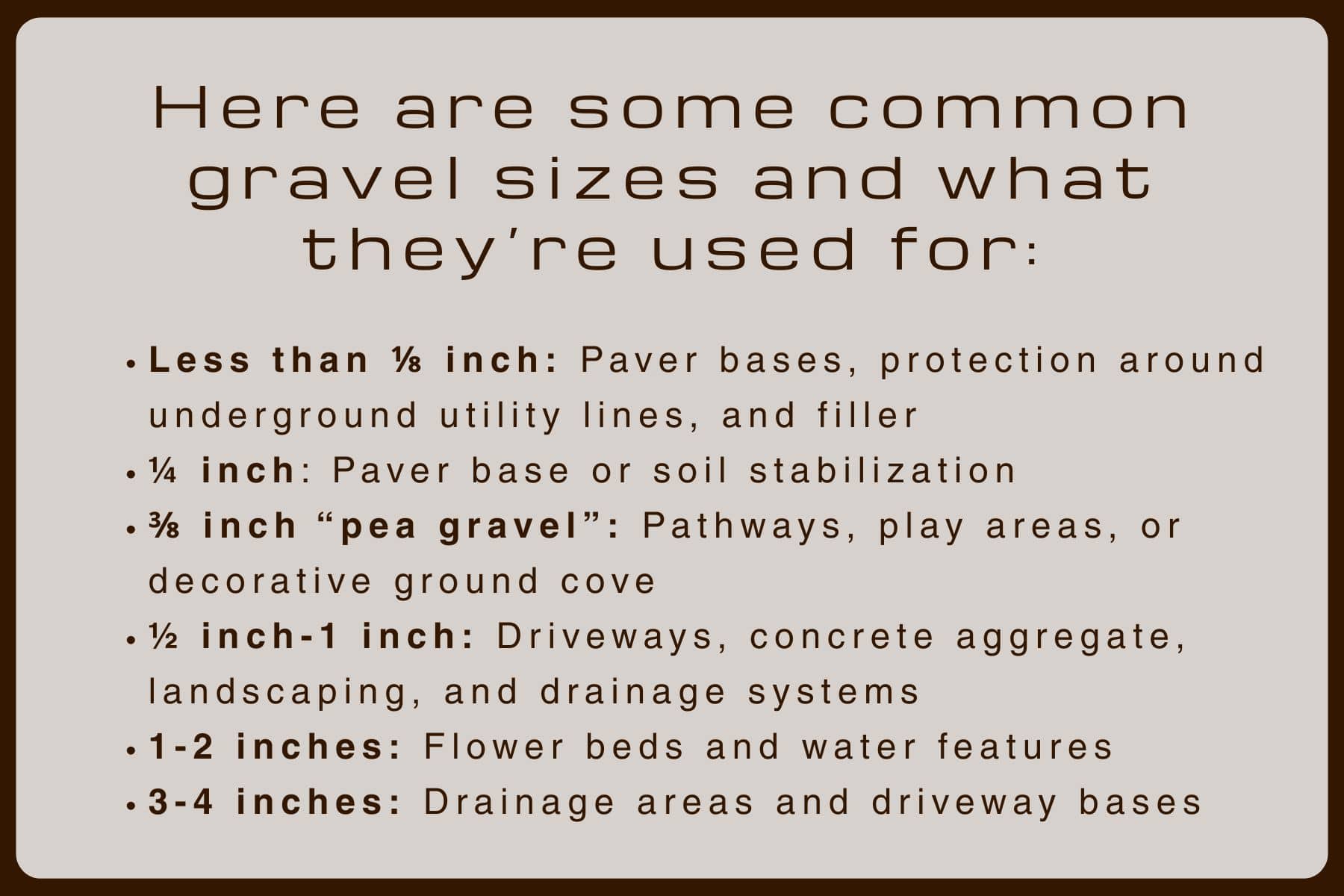
Less than ⅛ inch: Sometimes called “screenings” or “stone dust,” this size is used for paver bases, protection around underground utility lines, and filler.
¼ inch: This size compacts well but isn’t as good at drainage. It’s great for a paver base or soil stabilization.
⅜ inch “pea gravel”: These small, smooth stones are often used for pathways, play areas, or decorative ground cover, since they’re easy on bare feet!
½ inch-1 inch: This is a pretty common size for general projects like driveways, concrete aggregate, landscaping, and drainage systems.
1-2 inches: Natural, rounded stone in this larger size is popular for flower beds and water features.
3-4 inches: These bigger rocks work for drainage areas and driveway bases.
Other size considerations:
Some gravel comes with multiple sizes of rock, including gravel dust, and is designed to compact easily. This is often called “modified” gravel.
If your gravel is labeled “clean,” that means it does not include that gravel dust for compaction.
River gravel also often comes with various sizes together, but the purpose is aesthetics, not compaction.
Gravel for Specific Uses
Here's a breakdown of the types of gravel that work best for common gravel uses and the sizes that work best.
Driveways
For a sturdy, long-lasting driveway base, use gravel that includes a mix of crushed stone gravel up to 1.5 inches in size with fine particles (“modified” gravel). This combination compacts well and creates a solid foundation.
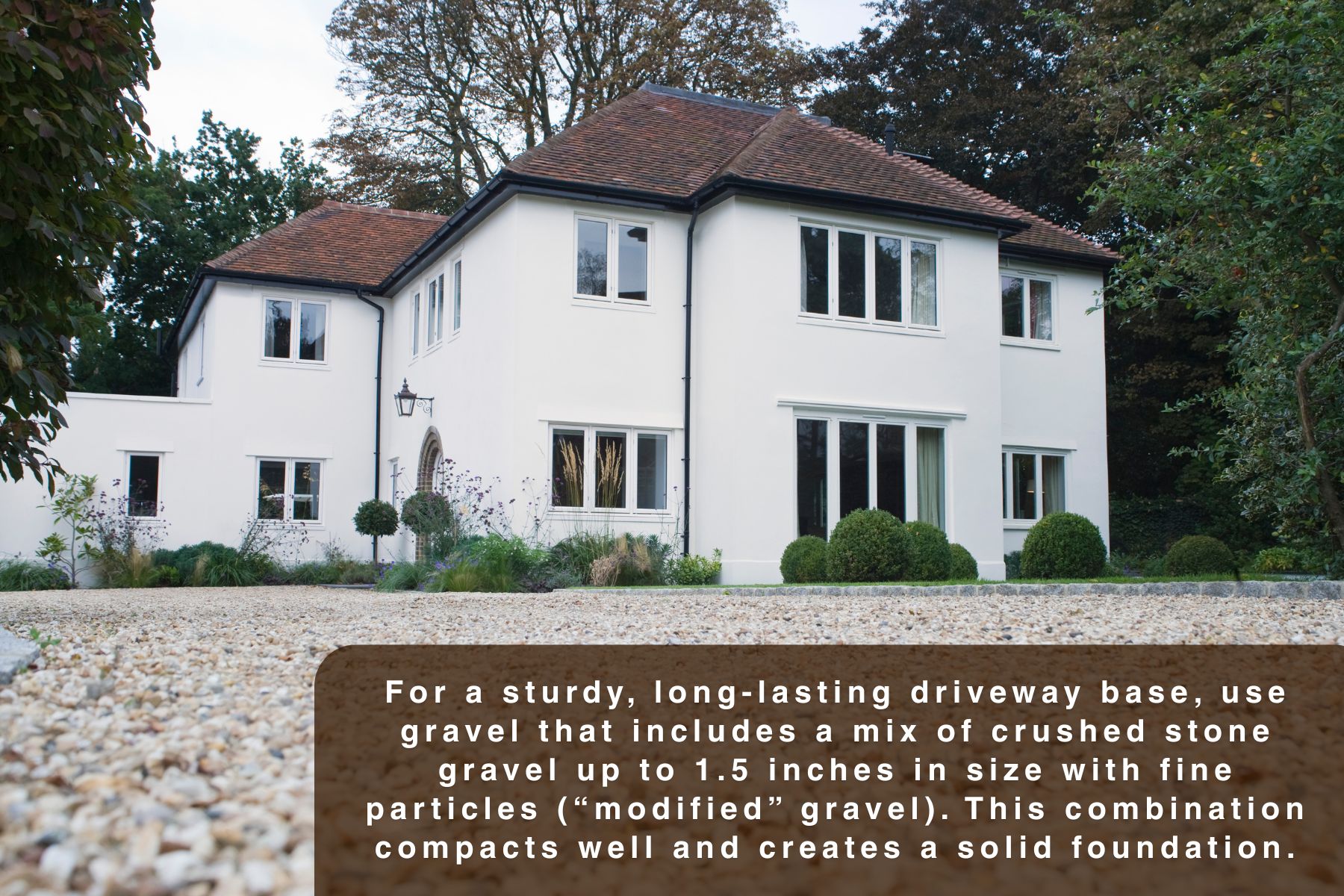
For a decorative top layer, gravel with stones about 3/4 inch in size offers good drainage and a clean, finished appearance. Smooth natural stones are easier to walk on than crushed stone, and you may like the appearance better, but make sure you have a good crushed stone base because the rounded natural stones shift around more under the weight of cars.
Drainage
If you’re working on a project where drainage is important—such as in French drains, around foundations, or behind retaining walls—use clean gravel with stone sizes between 1/2 inch and 1 inch. These larger, uniform stones allow water to pass through freely and won’t trap moisture.
Walkways and patios
Crushed gravel or limestone fines (particles smaller than 1/4 inch) are ideal for creating a smooth, level base under pavers. For gravel walkways, small, rounded stones around 3/8 inch in size (typically called “pea gravel”) provide a comfortable walking surface and an attractive look.
Concrete mix: When mixing your own concrete, use gravel that’s around 1/2 inch in size. This serves as the aggregate, giving strength and structure to the finished mix.
Erosion control and heavy-duty support: In areas with heavy runoff or where you need to support large loads, use gravel with stone sizes between 2 and 4 inches. These larger rocks resist shifting and help stabilize the ground.
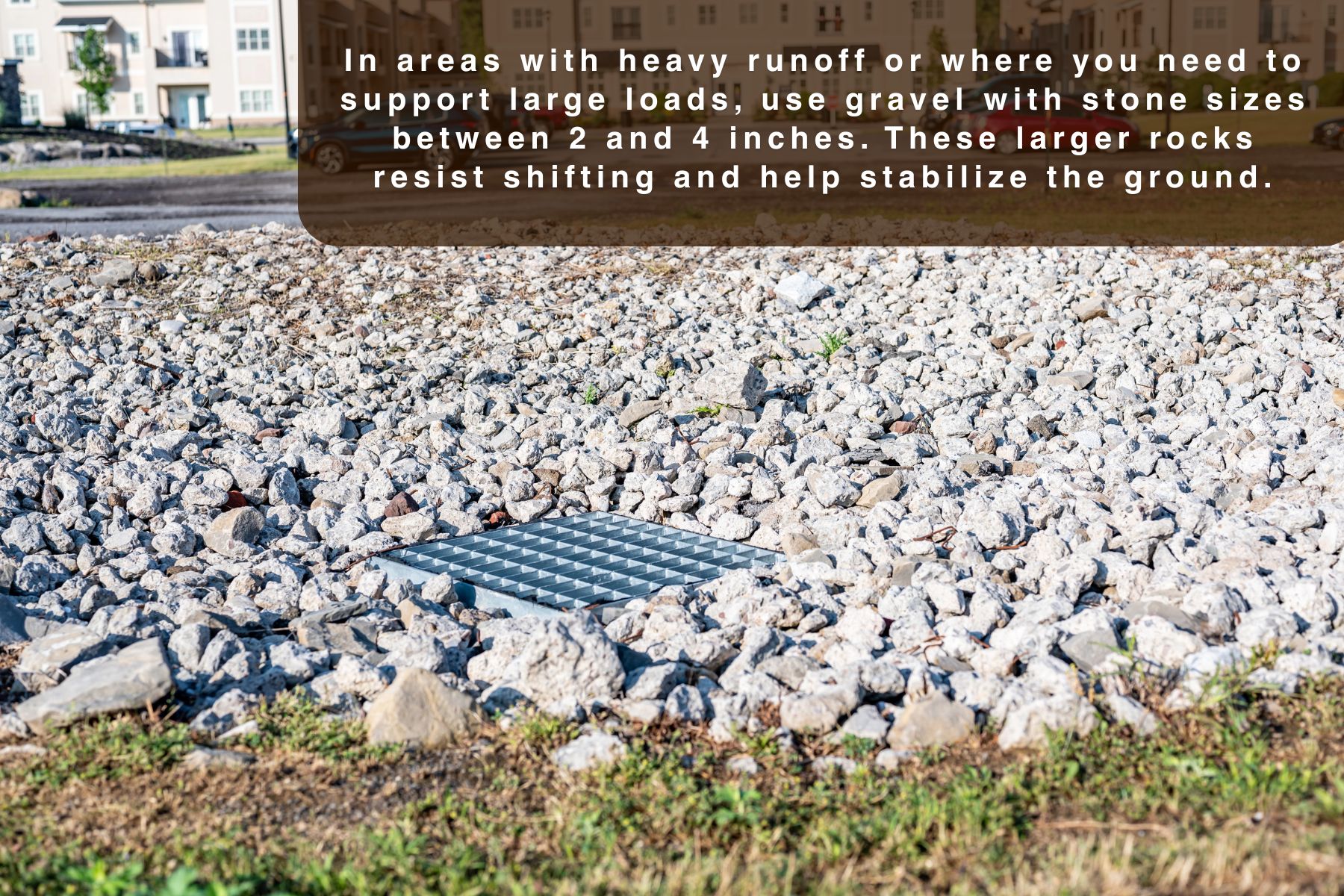
Landscaping
Finally, for landscaping projects, look for something between ¾ inches and maximum 2 inches that looks nice, is a pleasant color, and fits the look and feel you’re going for.
Note: If you’re interested in more landscaping tips and tricks, read our related blog posts:
How to Choose the Right Gravel for Your Project
When choosing the right gravel for your project, here are some things to keep in mind:
What’s close and available?
Local gravel will be cheaper and fit the look of your area.
What size do you need?
Choose a size suitable for your project, as outlined in the sections above. If you need more help knowing the right size, call your local landscape supply center that sells gravel, and tell them what your project vision is. They’ll be happy to help!
Do you want your rocks to compact?
If you want a stable, compact surface, crushed stone works best. Fine particles or modified gravel that includes rock dust is designed to compact well.
Do you want your rocks to drain well?
Larger rocks provide better drainage than small gravel bits or gravel dust.
What look are you going for?
If your gravel project is part of the landscaping, choose gravel that looks nice and matches the aesthetic of your home or business!

Where to Find Gravel For Sale in Central PA
If you live in or near Lebanon County PA, get your gravel from Zimmerman Mulch!
We offer a wide variety and selection of gravel products, including bagged gravel and bulk gravel options.
Whatever your project, Zimmerman Mulch has the product for you. And if you’re not sure what you need, call us or stop in to discuss your vision and let us help you find the right type of gravel!




